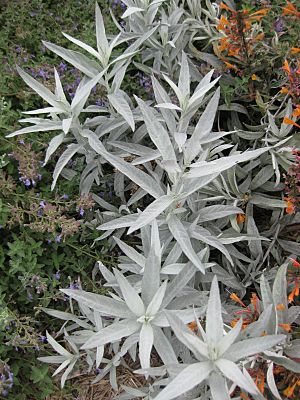Artemisia ludoviciana facts for kids
Quick facts for kids Artemisia ludoviciana |
|
|---|---|
 |
|
| Scientific classification | |
| Genus: |
Artemisia
|
| Species: |
ludoviciana
|
| Synonyms | |
|
Synonymy
Cacalia runcinata Kunth
Artemisia brittonii Rydb. Artemisia cuneata Rydb. Artemisia diversifolia Rydb. Artemisia falcata Rydb. Artemisia ghiesbreghtii Rydb. Artemisia gnaphalodes Nutt. Artemisia herriotii Rydb. Artemisia lindheimeriana Scheele Artemisia muelleri Rydb. Artemisia pabularis (A.Nelson) Rydb. Artemisia paucicephala A.Nelson Artemisia platyphylla Rydb. Artemisia pudica Rydb. Artemisia purshiana Besser Artemisia revoluta Rydb. 1916 not Edgew. 1846 Artemisia rhizomata A.Nelson Artemisia albula Wooton, syn of subsp. albula Artemisia microcephala Wooton 1898, syn of subsp. albula, not A. microcephala Hillebr. 1888 Artemisia candicans Rydb., syn of subsp. candicans Artemisia gracilenta A.Nelson, syn of subsp. candicans Artemisia latiloba (Nutt.) Rydb., syn of subsp. candicans Artemisia prescottiana Besser, syn of subsp. incompta Artemisia pumila Nutt., syn of subsp. incompta Artemisia arachnoidea E.Sheld., syn of subsp. incompta Artemisia atomifera Piper, syn of subsp. incompta Artemisia incompta Nutt., syn of subsp. incompta Artemisia lindleyana Besser, syn of subsp. incompta' Artemisia cuneifolia Scheele, syn of subsp. mexicana Artemisia mexicana Willd. ex Spreng., syn of subsp. mexicana Artemisia neomexicana Greene ex Rydb., syn of subsp. mexicana Oligosporus mexicanus (Willd. ex Spreng.) Less., syn of subsp. mexicana Artemisia redolens A.Gray, syn of subsp. redolens Artemisia sulcata Rydb., syn of subsp. sulcata |
|
Artemisia ludoviciana is a plant from North America. It belongs to the daisy family, Asteraceae. This plant has many common names, like silver wormwood, western mugwort, Louisiana wormwood, white sagebrush, and gray sagewort.
The name Ludoviciana is a Latin word. It means "from Louisiana," which is where the plant was first found or described.
Contents
What it Looks Like
Artemisia ludoviciana is a perennial plant. This means it lives for more than two years and grows back each spring. It grows from underground stems called rhizomes. These rhizomes help the plant spread.
The plant can grow to be about 1 to 3 feet (0.3 to 1 meter) tall. Its stems have long, thin leaves, up to 4 inches (11 centimeters) long. Both the stems and leaves are covered in soft, gray or white hairs, making the plant look fuzzy.
At the top of the stem, you'll find many small flower clusters. These clusters hang down a bit. Each tiny flower cluster is like a cup made of fuzzy leaves called phyllaries. Inside, there are small, yellowish flowers.
After the flowers bloom, the plant produces tiny fruits. These fruits are called achenes.
Where it Grows
This plant is native to North America. You can find it all over the United States, Canada, and Mexico. Some scientists think that the plants found in the eastern United States might have been brought there from the western and central parts of the continent.
Different Types (Subspecies)
Artemisia ludoviciana has several different types, called subspecies. These subspecies are slightly different from each other. They grow in various regions across North America. For example, some grow in deserts, while others are found in mountains.
- Artemisia ludoviciana subsp. albula grows in deserts from California to Mexico.
- Artemisia ludoviciana subsp. candicans is found in the Rocky Mountains and Cascade Range.
- Artemisia ludoviciana subsp. incompta lives in mountains from Canada down to Mexico.
- Artemisia ludoviciana subsp. ludoviciana grows in the western and central United States and western Canada.
- Artemisia ludoviciana subsp. mexicana is found in Mexico and parts of the United States.
- Artemisia ludoviciana subsp. redolens grows in states like Arizona, New Mexico, and Texas.
- Artemisia ludoviciana subsp. sulcata is found in parts of Mexico and Arizona.
How People Use It
Native American Uses
Native American tribes used Artemisia ludoviciana in many ways. They used it as a medicinal plant to help with different health issues. They also used its fibers to make household items. The plant was important for ceremonial purposes too.
- The Dakota people used this plant for protection.
- The Apache, Chiricahua, and Mescalero tribes used it as a spice.
- The Blackfoot tribe used it for skin problems.
- The Gros Ventre people also used it for skin care. They also used it as a medicine for colds because it could help reduce fever.
Growing in Gardens
Artemisia ludoviciana is also grown as an ornamental plant. This means people grow it in their gardens because it looks nice. Since it spreads with rhizomes, it can grow very quickly in some gardens.
Some popular types grown in gardens are 'Valerie Finnis' and 'Silver Queen.' These types are very strong and can survive cold winters. 'Valerie Finnis' has even won an award called the Royal Horticultural Society's Award of Garden Merit for being an excellent garden plant.
See also
 In Spanish: Estafiate para niños
In Spanish: Estafiate para niños


